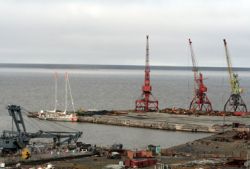September 2006, the departure from Tiksi
Published on 30.09.2006 - Tara Arctic
Having left from Lorient on July 11, the sailboat named Tara arrived in Tiksi on August 16. This harbour along the Lena river delta is the last stop-over before tackling the pack ice. A great moment of this navigation was the mooring in Norway along the pontoon of the Fram museum. This stop-over made the expedition members realize the importance of the project, and allowed them to better comprehend the conditions of the drift and to let their dream, and their fears, run wild regarding the life they will endure for the next two years.
On September 3, 2006, after having bought their last supplies, Tara finally cast off the lines. First objective of the crew: to position the ship the closest possible to the intended spot in order to drift (82°N, 140 E). This position should allow, in theory, a drift in the right direction. The men among the expedition will then have to find an ice cap large and thick enough to allow the schooner to be moored and the MI8 Russian helicopters to land without any danger. A Russian ice-breaker, the Dranitsyn, is preceding the French shipt to break up the ice in front of her.
On Sept 4, the objective has been achieved. The chosen position, 79°53.1N, 143°17.2E is more to the south than what was planned but the ice cap is really very good there, from 80 cm to 2m thick. Furthermore, progression through the pack ice had become impossible anyway
During the following days, establishment of the base continues. The rudder blade is removed, production of fresh water from pack ice is organized, and the two Russian members of the expedition, who came from Tiksi by helicopter, are welcomed on board. Photo shoots also take place, and the behaviour to adopt in front of bears is gone over just in case any should approach the boat too much. The crew repairs a small leak which had appeared in the bottom of the ship in Tiksi, probably due to the heavy load making the floor cave in. For the moment, their drift towards the east is averaging a speed of 0.2 knots (370 metres per hour). For comparison, Nansen, aboard his ship Fram, reported on Sept 20, 1893, a position of 77°44 north, having never moved northwards during his first month of drift.
Loaded on the back of the ship is the meteorological mast, meteorological observations being of major importance for this type of scientific adventure. This mast upon which has been mounted the meteorological station allows recording on three different levels (1, 5, 10 metres) of the temperatures, the direction and speed of the wind, and of the atmospheric pressure and hygrometry. They have also mounted on the side of the sailboat two sonic anemometers permitting a three-dimensional vision of the direction and speed of wind. The scientific importance of these instruments is to allow the study of movements occurring within the lower layers of the atmosphere and to integrate the turbulences within their observations.











